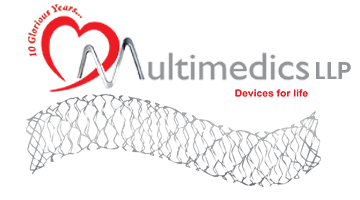Procedure in which a thin tube known as guiding catheter is inserted through groin or wrist and is then moved towards the site of blockage. A small balloon at the tip of the balloon catheter is inserted through the guiding catheter near the blocked or narrowed area of the coronary artery. (See figure below) When the balloon is inflated, the fatty plaque or blockage is compressed against the artery walls and the diameter of the blood vessel is widened (dilated) to increase blood flow to the heart. Once the plaque is compressed and the artery if opened sufficiently, the balloon catheter is deflated and removed.

Coronary Artery Stents
A stent is a small, metal mesh tube that acts as a scaffolding to provide support inside the coronary artery. The shape and material of the stent results in a flexibility which can be expanded by a balloon to adapt to the shape and curves of the artery.
Stent Implantation
Stent is introduced into the blood vessel through the femoral or radial artery on a balloon catheter and advanced to the blocked area of the artery. The balloon is then inflated; which causes the stent to expand until it fits the inner wall of the artery. The balloon is deflated and withdrawn. Stent stays in place permanently, holding the vessel open and improving the flow of blood.
Restenosis
Re-narrowing of coronary artery after it has been treated with either balloon or with the stent. The renarrowing can be caused by vessel recoil and formation of tissue growth in the treated area. The rate of restenosis in the patient treated with balloon is upto 30 to 50 % and with the stent (without drug) is upto 10 to 30 %.
What happens after the Angioplasty Procedure ?
After the Angioplasty Procedure, patients are taken to an intensive care unit with special monitoring equipment. Blood pressure, pulse monitoring and ECGs are performed routinely after Angioplasty procedures and do not signify any special problems. You may be asked to stay in hospital for 3 to 5 days depending upon the speed of your recovery.

